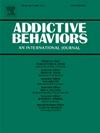Characteristics of adolescent cannabis use and social context predicting problematic use: A decision tree analysis
IF 3.6
2区 医学
Q1 PSYCHOLOGY, CLINICAL
引用次数: 0
Abstract
Identifying characteristics of adolescent cannabis use and the surrounding social context that may predict problematic use is important for delivering harm-reduction approaches in both clinical and public health settings. We used a decision tree analysis to identify combinations of various use characteristics (e.g., frequency, mode, duration, initiation age, polysubstance use) and social context risk factors (e.g., peer and household use, solitary use, ease of access) characterizing the highest risk groups for three indicators of problematic use (unsuccessful quit attempt, excessive use, feeling addicted). We analyzed data from 8,915 cannabis ever-users from a large sample of secondary school students (mean age 15.5) in Québec, Canada, who completed the COMPASS survey. Using cannabis at least 2–4 times per month was the most important predictor of problematic use and independently characterized the highest risk groups. Initiating use before age 14 and engaging in solitary use also predicted increased problematic use risk among adolescents whose sustained past-year use did not meet the 2–4 times per month threshold. No sociodemographic differentiation emerged among high-risk groups. When screening for risky cannabis use or promoting safer cannabis behaviours among adolescents, health care providers and public health groups should consider factors with the greatest potential to influence detrimental trajectories among this age group.
青少年大麻使用特征和社会环境预测问题使用:决策树分析
确定青少年大麻使用的特征以及可能预测有问题使用的周围社会环境,对于在临床和公共卫生环境中提供减少危害的方法非常重要。我们使用决策树分析来确定各种使用特征(例如,频率,模式,持续时间,起始年龄,多种物质使用)和社会环境风险因素(例如,同伴和家庭使用,单独使用,易于获取)的组合,以确定问题使用的三个指标(戒烟失败,过度使用,感觉上瘾)的最高风险群体。我们分析了8,915名曾经吸食过大麻的中学生(平均年龄15.5岁)的数据,这些中学生完成了COMPASS调查。每月至少使用2-4次大麻是问题使用的最重要预测因素,并独立表征了最高风险群体。在14岁之前开始使用和单独使用也预示着过去一年持续使用未达到每月2-4次阈值的青少年的问题使用风险增加。在高危人群中没有出现社会人口统计学差异。在筛查青少年使用大麻的风险或促进更安全的大麻行为时,卫生保健提供者和公共卫生团体应考虑最有可能影响这一年龄组有害轨迹的因素。
本文章由计算机程序翻译,如有差异,请以英文原文为准。
求助全文
约1分钟内获得全文
求助全文
来源期刊

Addictive behaviors
医学-药物滥用
CiteScore
8.40
自引率
4.50%
发文量
283
审稿时长
46 days
期刊介绍:
Addictive Behaviors is an international peer-reviewed journal publishing high quality human research on addictive behaviors and disorders since 1975. The journal accepts submissions of full-length papers and short communications on substance-related addictions such as the abuse of alcohol, drugs and nicotine, and behavioral addictions involving gambling and technology. We primarily publish behavioral and psychosocial research but our articles span the fields of psychology, sociology, psychiatry, epidemiology, social policy, medicine, pharmacology and neuroscience. While theoretical orientations are diverse, the emphasis of the journal is primarily empirical. That is, sound experimental design combined with valid, reliable assessment and evaluation procedures are a requisite for acceptance. However, innovative and empirically oriented case studies that might encourage new lines of inquiry are accepted as well. Studies that clearly contribute to current knowledge of etiology, prevention, social policy or treatment are given priority. Scholarly commentaries on topical issues, systematic reviews, and mini reviews are encouraged. We especially welcome multimedia papers that incorporate video or audio components to better display methodology or findings.
Studies can also be submitted to Addictive Behaviors? companion title, the open access journal Addictive Behaviors Reports, which has a particular interest in ''non-traditional'', innovative and empirically-oriented research such as negative/null data papers, replication studies, case reports on novel treatments, and cross-cultural research.
 求助内容:
求助内容: 应助结果提醒方式:
应助结果提醒方式:


